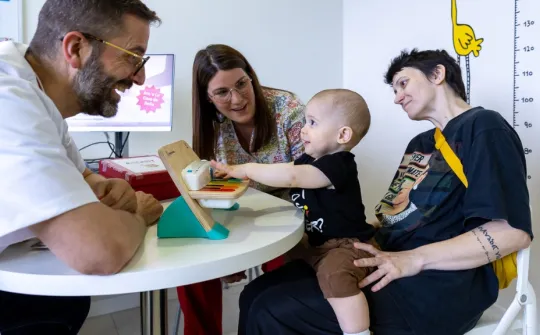We are specialists in the treatment of amniotic band syndrome and in the precise fetal surgery for its treatment.
Pathology description
The fetus develops in the cavity of the uterus, which is covered by a thin double membrane called the amnion, which is normally well attached to the inner wall of the uterus and placenta. In rare circumstances, a part of this membrane, or band, disengages and may be left floating in the uterine cavity.
When this occurs, fetal body parts can become entangled in an amniotic band, which can constrict them. Of all the parts of the fetal body, the limbs (arms, legs, hands, feet, and fingers) are the most at risk of becoming entangled in an amniotic band. If the tangle is tight enough to reduce blood flow in the limb, the development of the limb may be affected. When an amniotic band causes such damage to a part of the fetal body, it is called amniotic band syndrome.
Amniotic band syndrome is very infrequent, affecting fewer than 1 in 5000 newborns. It is usually diagnosed at birth, but can sometimes be detected in utero by ultrasound.
Why does it occur?
The cause is unknown, but it rarely has a familial or genetic origin, and it may also result from amniocentesis or fetal surgery.
Amniotic band syndrome can occur when the amniotic membrane is damaged during pregnancy and the amnion disengaged. When this happens, thin strands of tissue (amniotic bands) form within the amniotic cavity. These bands are very adhesive and can become entangled around the developing fetus, restricting blood flow and thus affecting the growth of certain parts of the body.
What consequences can amniotic band syndrome have for fetal development?
The type of problems that amniotic bands produce depends on when the body part is trapped during pregnancy,whether or not the blood flow is cut off, and of course whether other areas of the body are trapped or attached.
It is usually a limb that becomes entangled in an amniotic band. The distal parts of the limb (hands, feet and fingers) are at risk of various problems. When the limb is compromised, there may be swelling of the distal parts, developmental abnormalities with physical deformity or even a complete amputation.
Less frequently, an amniotic band can also affect the development of other parts of the body and produce large, sometimes irreversible and deformed lesions, such as if the band passes over the trunk, face, penetrates the brain or affects the genitals.
There are also cases in which the amniotic band surrounds the umbilical cord of the fetus, causing obstruction of blood flow and fetal death.
Diagnosis
The diagnosis of mild cases is usually made after birth while prenatal diagnosis is usually made in the most serious cases, when sometimes we can already see irreparable injuries by ultrasound. But in some cases fetal surgery can improve the postnatal prognosis of associated lesions, or can even save fetal life if the umbilical cord is being compressed by a band.
Treatment
The goal of fetal surgery is to release the constriction caused by the amniotic band before it can cause more damage.
Fetal surgery is performed by fetoscopy in the operating theatre. Under local anaesthesia, a minimal incision of about 3 mm is made in the abdomen of the pregnant woman and with ultrasound control the endoscope is inserted into the uterine cavity. In this way, the direct visualization of the amniotic bands and the degree of involvement of the different fetal parts is enabled and the possibility of achieving their release through various surgical techniques is evaluated.
The success of fetal surgery depends on the degree of damage caused by the amniotic band. If the distal part of the limb is swollen, the release of the band allows the swelling to resolve and normal development to continue. If the constriction has been more severe, the release of the band can stop further damage and even prevent distal amputation of the affected limb.
What appointments are needed for fetal surgery?
An in-patient admission of the pregnant woman will initially last 1–2 days and afterwards weekly check-ups with examination and ultrasound will be required, and she will have to maintain a low-activity lifestyle mainly at home until the end of pregnancy, especially for the first 3-4 weeks after the intervention. Normally, childbirth can be performed at term without any need to induce it prematurely.
Treatment after birth consists of plastic and reconstructive surgery, followed by physiotherapy and occupational therapy, as required by the type of involvement.
During pregnancy, you will receive the support of nurses specialized in fetal medicine, not only on a technical level but also on an emotional level throughout the process. In addition, we can put you in contact with other families who have gone through the same experience. This is very positive and helps to humanize and understand the problem in a much more intuitive way and without the difficulties that sometimes arise when receiving only technical information from professionals.
Why BCNatal - Sant Joan de Déu?
For parents who want to continue their pregnancy care and have their baby with us, we offer a fetal surgery team with the best survival figures and quality of life that can currently be obtained.
We are one of the few centres in the world that perform fetal surgery for amniotic band syndrome.
Experience and efficiency
We are one of the few centres in the world that perform fetal surgery for amniotic band syndrome.
- Severe presentation of this condition is very rare, therefore treatment for it is offered in a small number of hospitals in the world, none of which see a large number of cases. It is a complex, delicate and very high precision treatment. With these difficulties, we are one of the few centres in the world that have performed fetal surgery for this disease.
- We are among the centres with the most extensive experiences in fetal surgery in the world, with more than 2000 interventions performed, the shortest surgical times reported in the medical literature and, consequently, very low rates of complications.
- Our fetal surgery team offers the best survival and quality of life figures that can currently be obtained.
We are a multidisciplinary team, which allows us to approach surgery in a comprehensive way.
Personalized patient-centered care
We are a multidisciplinary team, which allows us to approach surgery in a comprehensive way.
Before surgery we evaluate each case in detail, performing very high-resolution ultrasound and magnetic resonance tests, and perform analysis in multidisciplinary teams that include experts in each of the fields, including fetal medicine, fetal and pediatric surgery, otoraryngologists, neonatologists, radiologists and any other specialty that may be necessary.
We will discuss the case in detail with the parents and talk about the best options for your baby. Parents will be able to speak in detail not only with specialists in medicine and fetal surgery, but also with pediatricians who are experts in the monitoring and evolution of these children, to get to know in detail the expected evolution in each case and the best options.
We accompany you with an individualized postnatal follow-up
After the birth we continue with our patients
We accompany you with an individualized postnatal follow-up
To the excellence of the prenatal team is added a third-level paediatric centre that has teams formed by a large number of specialists with specific training in the postnatal treatment of this kind of injury. Paediatric surgeons, also part of the prenatal team, will continue to care for the baby once it is born.
Treatment after birth consists of reconstructive plastic and orthopaedic surgery of the affected parts, followed by physiotherapy and occupational therapy as required by the type of involvement. In some cases it will be necessary to recommend prostheses for children who suffer loss of limbs or of their functionality. Advances in 3D printing have led to the creation of more functional prostheses for such patients.
For surveillance during the first days after birth, the hospital has highly qualified medical and nursing professionals caring for these delicate patients 24 hours a day, 365 days a year.
As a pioneering development centre in fetal surgery, we continuously research and incorporate technologies that further improve accuracy, such as computer guidance techniques and robotic assistance.
Our professionals












